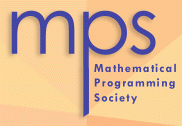|
2006
Fulkerson Prize Citation
Manindra Agrawal, Neeraj Kayal and Nitin Saxena,
"PRIMES is in P", Annals of Mathematics, Volume 160, issue 2, 2004,
Pages 781--793.
Testing whether an integer is a prime number is one of the
most fundamental computational and mathematical problems. The existence
of short certificates for both compositeness and primality was known
since the 70's and suggested that primality testing might be in
P. Yet, despite numerous efforts and a flurry of algorithms, it was
not until 2002 that Agrawal, Kayal and Saxena devised the first
deterministic polynomial-time algorithm for primality testing. Earlier
algorithms had either assumed the generalized Riemann hypothesis, or
been randomized or had been only subexponential. This is a stunning
development. This result is a true masterpiece, combining algebraic and
number theoretic results in a seemingly simple way.
Mark Jerrum, Alistair Sinclair and Eric Vigoda,
"A polynomial-time approximation algorithm for the permanent of a
matrix with nonnegative entries",
J. ACM, Volume 51, Issue 4, 2004, Pages 671--697.
The permanent of a matrix has been studied for over two
centuries, and is of particular importance to statistical physicists
as it is central to the dimer and Ising models. For a 0-1 matrix, it
represents the number of perfect matchings in the corresponding
bipartite graph. Although polynomial-time computable for planar
graphs, the computation of the permanent is #P-complete for general
graphs as shown by Valiant in 1979. This opened the search for
approximation schemes. In this paper, Jerrum, Sinclair and Vigoda give
the first Fully Polynomial Randomized Approximation Scheme for
computing the permanent of any 0-1 matrix or any nonnegative
matrix. This is a remarkable result. Their algorithm is based on
updating a Markov chain in a way that quickly converges to a rapidly
mixing non-uniform Markov chain on perfect matchings and near-perfect
matchings. Their work builds upon the earlier pioneering work of
Jerrum and Sinclair who initiated the use of rapidly mixing Markov
chains for combinatorial problems.
Neil Robertson and Paul D. Seymour, "Graph
Minors. XX. Wagner's conjecture", Journal of Combinatorial Theory,
Series B, Volume 92, Issue 2 , 2004, Pages 325--357.
Kuratowski's theorem says that a graph is planar if and only
if it does not contain K_5 or K_{3,3} as a minor. Several other
excluded minor characterizations are known, and Wagner conjectured
that any minor-closed graph property can be characterized by a finite
list of excluded minors. Restated, this says that for any infinite
family of finite graphs, one of its members is a minor of another
one. In a remarkable tour de force, Robertson and Seymour proved
Wagner's conjecture, and this paper appeared as part 20 of their
monumental work on the theory of graph minors. Their proof of the
Graph Minor Theorem required the development of many graph theoretic
concepts, such as linkages and tree-width. This is a spectacular
achievement in graph theory with far reaching consequences. It shows,
for example, that embeddability in any fixed surface can be
characterized by a finite list of excluded minors, or that the
disjoint paths problem can be solved in polynomial time for a fixed
number of terminals.
|

![]()